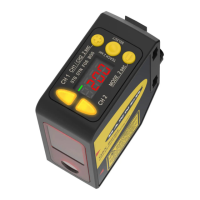July 25, 2023
Q5X With Dual Discrete Outputs And IO-Link Instruction Manual
49
Chapter Contents
Dual (Intensity + Distance) Mode ...................................................................................................................................................................... 49
Dual Mode Reference Surface Considerations................................................................................................................................................. 49
Dual Mode Considerations for Clear and Transparent Object Detection .......................................................................................................... 50
Abbreviations.................................................................................................................................................................................................... 51
Dual (Intensity + Distance) Mode
DualTEACHmode,dualintensity+distancewindow,expandstheapplicationstheQ5Xcansolvebycombiningdistance
baseddetectionwithlightintensitythresholds.
Inbackgroundsuppression(DYN,1pt,2pt)andforegroundsuppression(FGS)TEACHmodes,theQ5Xsensorcompares
changes in the measured distance between the sensor and target to control the output state. In dual TEACH mode, the user
teachestheQ5Xafixedreferencesurface,andthesensorcomparesintensityanddistancereadingsagainstthereference
surface it was taught. After teaching the reference target, the displayed value is calibrated to 100P, or a 100% match. When
anobjectentersthesensor’sfieldofview,thedegreeofconsistencywiththereferencesurfacebecomeslowerandcausesa
changeinsensoroutput.
In dual mode, you can detect when the target is present at the right distance and when it returns the right amount of light.
This is useful in error-proofing applications where you need to know not only that the part is present (distance), but also that it
isthecorrectpart(intensity).
Indualmode,theQ5Xrequiresareferencesurface(farleft).Oncetaught,thedistanceandintensityofthereferencesurface
are recorded and used as a baseline. A user-adjustable switching threshold is set, and changes in distance and/or intensity
outside the switching threshold creates a sensor output change. The example uses a 90% (90P) match condition with a 10%
change in intensity and/or distance from the reference surface required to change the output state. The default-switching
threshold is a 50% match to the reference condition (50P); this sets the threshold 50% from the distance and intensity of the
referencesurface.Atransparentobjectcanbedetectedeitherbyachangeinintensity,distance,orbyadoublepeakreflec
tion(farright).
Dual Mode Example
Reference Condition
0
0
Change in Intensity
0
0
Output switches with intensity change
Change in Distance
0
0
Output switches with distance change
0
0
Output switches with intensity and distance change
Reduced Intensity and/or Second Peak
0
0
Output switches with intensity and/or second peak (Clear Object Detection)
TheQ5Xsensorcanbetaughtnonidealreferencesurfaces,suchassurfacesoutsideofthesensor’srange,verydarksur
faces,orevenemptyspace.Thesesituationsmayenableapplicationsrequiringalongrangedetectionbutaresubjecttotyp
icaldiffusemodedetectionchallenges.
Dual Mode Reference Surface Considerations
Optimizereliabledetectionbyapplyingtheseprincipleswhenselectingyourreferencesurface,positioningyoursensorrela
tivetothereferencesurface,andpresentingyourtarget.
TherobustdetectioncapabilitiesoftheQ5Xallowssuccessfuldetectionevenundernonidealconditionsinmanycases.Typ
icalreferencesurfacesaremetalmachineframes,conveyorsiderails,ormountedplastictargets.ContactBannerEngineer
ingifyourequireassistancesettingupastablereferencesurfaceinyourapplication.
Additional Information
Selectareferencesurfacewiththesecharacteristicswherepossible:
© Banner Engineering Corp.

